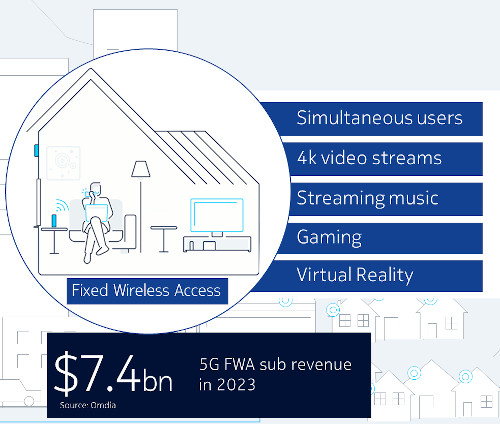FWA: A path to 5G profitability
By: Keith Russell

Investment in 5G radio upgrades are ramping up around the globe—and for good reason. There is an entire universe of use cases for 5G that are going to be game-changing. It seems that there is always a story in the trade press on how 5G will enable connected vehicles, eHealth, cloud-based robotics and more. Of course, it will take time for the overall ecosystem for these use cases to develop, and many of us will wait a while before signing up for 5G remote surgery.
But that’s OK. 5G has plenty of utility today. It’s a competitive market, so operators aren’t waiting for the full promise of 5G to emerge before investing. Global 5G deployments began in 2019 and are gathering steam in 2020.
Money, money, money
So where will early 5G revenues come from? Clearly mobile services, the bread and butter of every preceding “G”, is the first choice. According to the GSMA, smartphone sales volumes dropped by 2 percent in 2019, but there’s a clear focus on 5G handsets in regions where 5G is being deployed, with 20 new models launched just in Q1 2020, and about 40 percent of the 5G handset market in a single quarter. The challenge here is in consumer reluctance to pay more for higher speeds. This is reflected in GSMA reports showing four-fold growth in mobile data use by 2025 with 1 percent annual revenue growth in the same time period. Operators have their ROI work cut out for them if they focus on mobile broadband alone.

The answer lies in 5G fixed wireless access (FWA). A recent survey of communication service providers by Omdia show that they rate FWA as the top 5G use case after
enhanced mobile broadband (eMBB) with 47 percent of respondents rating it in the top two. With its 10-25x increase in capacity over 4G, 5G will change the face of FWA forever with speeds that
truly compete with fixed broadband services.
Figure 1: 5G Revenue Forecast
Consumers want 5G FWA, too. They may not understand 5G networks like those of us in the industry, but they do know that 5G is fast, and they like fast. A recent Parks Associates consumer survey shows that 76% of respondents like the idea of 5G FWA and 66% would happily subscribe to 5G FWA at the same price as their current broadband. The downside is that, just as with mobility, consumers don’t want to pay more just because it’s 5G.
5G fixed wireless access brings a multitude of services and revenue opportunities beyond commodity broadband pricing, in the same way we see today with mobile broadband. Omdia predicts that FWA will generate $7.4 billion in subscriber revenue in 2023.
For many mobile operators, 5G FWA represents a brand-new service driving all new revenues. Then, once subscribers are connected, operators have the opportunity to generate additional revenues through their own value-added services or by monetizing partnerships as distributers of streaming content.
Converged operators already have a keen understanding of consumer behavior in the home. They tend to have service offerings beyond basic broadband, either in-house or through partnerships. For them, the advantage of FWA is in bringing connectivity to all subscribers in their service area quickly and at a lower cost. This is generally achieved through a mix of technologies such as fiber-to-the-home (FTTH) or fiber-to-the-x (FTTx), which runs fiber deep into the network while using existing copper or coax infrastructure to connect the final meters to the home. Fixed wireless access plays the same role, using Radio Access Networks (RAN) for the final connection to the subscriber.


















